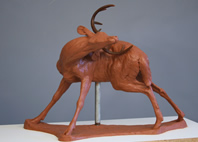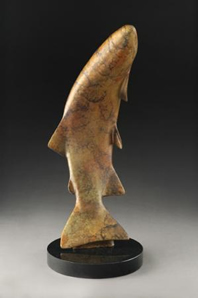
Wild Life & Times: January 2011 Edition

New Work: Ahh... right there
Ahh… right there is a sculpture of an old whitetail buck reaching around with his antler to scratch the spot that itches. The inspiration for this piece came from a photo by Colorado wildlife photographer Michael Mauro.
You can learn about the great pre-cast pricing currently available and view more details about Ahh… right there at my website.
Additionally, I've posted a short video at youtube.com that details this piece.

Society of Animal Artists
Earlier this year I was grateful to have my Rainbow Trout sculpture selected for the 50th Anniversary Annual Exhibition of the Society of Animal Artists at the San Diego Natural History Museum. It will be featured in an encore display at The Wildlife Experience in Denver November 20, 2010 - February 20, 2011.
In addition, Rainbow Trout, has also been chosen for display at these venues:
» Dunnegan Gallery of Art in Bolivar, MO — March 13 - April 10, 2011
» Sam Noble Oklahoma Museum of Natural History on the campus of the University of Oklahoma — April 30 - September 5, 2011

This image is courtesy of fellow artist Kim Diment.
Creature Feature: How Deer Cope with Winter
Winter can be a tough time for deer, but here is how they manage.
Their needs can be grouped into two general areas: Storing/conserving energy and protection from the elements. Putting on fat reserves (storing energy) and a winter coat (protection) start in the fall with the shortening of days. These events are triggered by the seasonal changes in the amount of light that enters an animal's eye (Photoperiodism).
Fattening time is made easier as it coincides with the maturing of the acorn crop. Acorns are high in fat and protein making them ideal for piling on some pounds. (And all this time I thought it was chocolate!) The need for fat reserves is so important that even undernourished young deer will put on fat at the expense of growth during the fall.
The deer go through two complete hair molts each year. In my area the summer hair gives way to the new winter hair in September. The role of the shorter, denser summer coat is great for staying cool and insect protection but offers little insulation value. The longer winter hair is hollow and thicker except for the point of connection which is smaller. The hollowness serves as insulation while the smallest possible root keeps the deer from losing heat by means of conduction. There is also a very fine, soft undercoat that comes in later in the fall.
As the days continue to shorten this causes a reduced thyroid function and their metabolic rate to drop to half of normal. As winter sets in and temperatures drop, so does the deer’s food intake, activity and weight. Even the heart rate decreases.
To escape the cold they spend a lot of time bedded in areas that give them protection from the wind: thick woods, brushy creek bottoms or a marsh.
One of my biggest questions was “how do they keep their legs warm?” I can understand how the thick body hair works, but the short dense hair on the legs can’t provide much insulation from the cold. Come to find out, they don’t keep their legs as warm as their bodies. The leg/foot tissue can function at lower temperatures. Then how do the legs not act as a radiator and cool the whole body? The answer is a countercurrent heat exchange system. The arteries, which carry warm blood from the heart, lie very close to the veins, which carry cold blood from the legs. At this point a heat exchange takes place where the outgoing blood warms the incoming blood thereby minimizing core body heat loss. Research on caribou with this characteristic show that while its body temperature to be 105°F its legs stay about 50°F or less. What a brilliant design!
